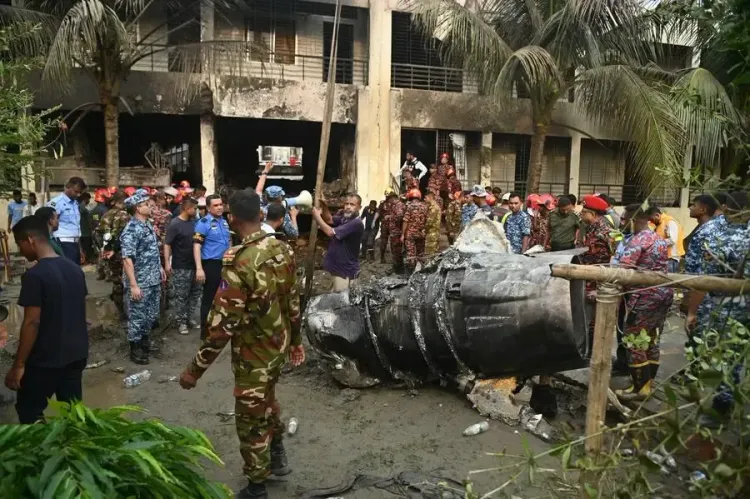Is Bangladesh's Heavy Dependence on Outdated Chinese Defence Equipment a Risk?

Synopsis
Key Takeaways
- Heavy reliance on outdated Chinese defence equipment poses risks.
- 35 lives lost in the recent crash highlight safety concerns.
- Criticism of the government’s military procurement strategies is mounting.
- Ongoing ties with China raise questions about national autonomy.
- Calls for reassessment of defence strategies are growing.
Dhaka, July 26 (NationPress) The interim government of Bangladesh, under the leadership of Muhammad Yunus, has faced intense backlash for their unquestioning dependence on Chinese-manufactured defence equipment, particularly after the devastating Bangladesh Air Force jet crash that has tragically resulted in 35 fatalities, primarily affecting children.
According to the Inter-Services Public Relations (ISPR), the media segment of the Armed Forces of this South Asian nation, a Chinese-made F-7 BGI training aircraft of the Bangladesh Air Force took off at 1:06 PM local time on Monday and crashed into the Milestone School and College building in Uttara, Dhaka around 1:30 PM.
As condolences continued to flow in, numerous local students, educators, and parents took to social media to voice their outrage over the risky use of a fighter jet for training purposes by the Bangladesh Air Force, culminating in this tragic air crash and the loss of young lives.
An analysis by the esteemed independent journal 'Eurasia Review' indicates that the F-7 BGI crash highlights Bangladesh's perilous bond with China, a partnership that originated during the tenure of the first military dictator and founder of the Bangladesh Nationalist Party, Ziaur Rahman.
Despite widespread national indignation, the Yunus-led interim government has reportedly finalized a new agreement to procure 16 JF-10C multirole fighter jets from China. This decision has been described as reckless and an illustration of irresponsibility following the tragic incident involving the Chinese aircraft on July 21.
A retired BAF officer, speaking anonymously to the journal, confirmed that the Chinese aircraft are a significant contributor to recurrent accidents, yet Dhaka's dependence on such equipment persists.
Even after multiple incidents involving Chinese aircraft, it is reported that Bangladesh continues to operate around 40 F-7BGIs, all sourced from China. This overwhelming reliance on outdated Chinese-manufactured aircraft presents a serious and ongoing risk that the interim government has yet to adequately address.
Since assuming power last year, the Yunus-led interim government has visibly enhanced Bangladesh's ties with China and Pakistan, aligning with Beijing’s strategic ambitions.
The Eurasia Review noted, “Instead of recognizing and learning from past errors, the interim government appears intent on pushing forward with plans to acquire 16 new JF-10C fighter jets despite the recent catastrophic crash of a Chinese F-7BGI aircraft in Dhaka.”
Reports indicate that Bangladesh’s growing engagement with China transcends military hardware, with Beijing’s expanding presence observable in highways, ports, nuclear projects, and digital infrastructure across the nation.
While Chinese-manufactured aircraft reportedly dominate Bangladesh’s aviation sector, critics warn that this trend reflects a disturbing trajectory in which the South Asian nation seems to be relinquishing its national sovereignty.
Experts have raised questions about the foreign policy and defence strategy that Bangladesh envisions under Yunus’s leadership—whether it will prioritize security, transparency, and national interests or continue its reliance on Beijing's low-cost aircraft models.









